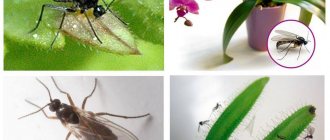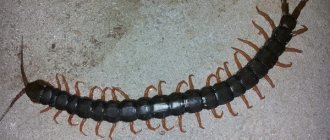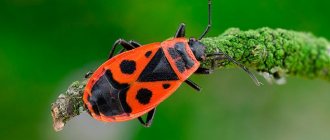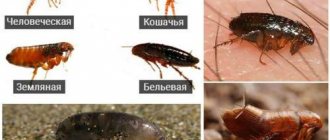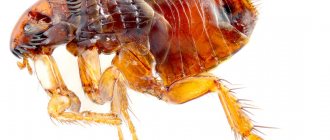Biological features of spider mites
Spider mites belong to the class of arachnids. Their lifespan is only 2-4 weeks, but due to their fertility, they are able to quickly spread throughout the plant and destroy it.
Only fertilized females can survive unfavorable environmental conditions. They overwinter under the bark, in dry leaves. In apartment conditions, they find shelter in the cracks of the window sill, window frames, and flowerpots.
With the onset of the warm season, females lay eggs on the underside of the leaves, entangling them with a web.
The web plays an important role in the life of ticks:
- Protection from adverse environmental conditions: precipitation, wind, low ambient temperature.
- Resettlement into free areas.
Parasites grow and multiply most quickly at high temperatures of 28 - 30C and low air humidity. During the summer period, 8 to 18 generations can change, depending on the region of residence.
In greenhouse and apartment conditions, development cycles occur all year round.
Why is it dangerous?
Spider mites are herbivorous arachnids.
Their main food is cell sap, which they suck out through numerous punctures on the leaves. The affected leaves dry out and fall off, the plant cannot develop normally, form buds and fruit ovaries.
Moving from one plant to another, mites carry dangerous viruses, fungi, and bacteria. Arachnids are not capable of flying, but are easily transported by the wind along with cobwebs. After overwintering, the pests quickly restore the population and can completely destroy the crop.
Stages of tick development
- Egg. The rate of embryo development depends on the ambient temperature. The higher it is, the faster hatching will occur.
- Larva. After birth, she immediately begins to feed on plant juice. Unlike the adult, which has 8 legs, the larva has 6 limbs. Development occurs within 1 – 3 weeks.
- Nymph. This is a grown larva, but not yet an adult, already having 4 pairs of limbs.
- Adult (imago), pictured.
Signs of spider mite infestation
This microscopic species of mites parasitizes house plants.
It is quite difficult to see it with the naked eye; the size of females is approximately 1/2 mm, and males - 1/3 mm. Therefore, it can be detected by indirect signs:
- Marbling, yellowing, drying of leaves. These symptoms are the earliest; when they appear, you should carefully look at the back of the sheet. There you can see a thin cobweb, and on it there are tiny dots of black or red color - these are adult individuals. They will sit still or move.
- The presence of a clearly visible web.
What plants does the pest attack?
Among vegetables, spider mites often attack cucumbers, tomatoes, eggplants, peppers, legumes, and pumpkin crops .
Strawberries, gooseberries, currants, raspberries, and grapes are damaged by insects .
Spider mites harm fruit trees: apple trees, pears, apricots, cherries, plums, cherry plums .
The parasite loves flowers and ornamental plants: roses, asters, palm trees, fuchsias, callas, citrus fruits, orchids, impatiens, abutilons, ficuses, saintpaulias, cyclamen, pelargoniums, azaleas .
How to deal with spider mites
The following methods are used to control the pest.
Mechanical
This method involves removing parasites manually. It is suitable for single specimens with large leaves.
- It is necessary to thoroughly wash the leaves, especially the lower part, with soapy water using a soft sponge or cotton swab.
- Then rinse thoroughly with clean water.
- You should first cover the pot with a plastic bag to prevent soap from getting on the soil.
Biological
The best remedies for spider mites are biological, because they are absolutely safe for humans, animals, and birds.
- Predatory mites are used as a pest control measure: Phytoseiulus persimilis, as well as Amblyseius. In nature, they feed on spider mites. Predators are successfully used in greenhouses and greenhouses.
- Biological drugs. They are obtained using strains of special microorganisms. Some of the most popular drugs are Fitoverm, Akarin.
Chemical
This method immediately gives a visible effect. The chemicals are called acaricides. They are used only in extreme cases, if the areas are too large or difficult to process in other ways.
- Apollo. Has a detrimental effect on eggs and larvae. It does not destroy adult individuals, but sterilizes them. Release form: emulsion in ampoules and bottles. Safe for bees and insects.
- Actellik. The drug acts against arachnids and insects.
- Anti-mite. A highly effective drug, it is toxic for people and insects.
- Neoron. Destructive for adults and larvae. It is not dangerous for bees; it is allowed to be used during the flowering period.
Important: due to the toxicity of chemicals, personal safety precautions should be observed.
Reasons for appearance
Before you start fighting spider mites, it is worth identifying the reason for their appearance in the apartment.
Pest activity in a residential area begins in winter , when the heating is on and the air becomes dry. Those plants that are located near heating radiators are affected by mites in case of infrequent watering.
On a note. Often an infected flower is brought from the store. Do not forget that it is impossible to see the pest on the plant until the lesions reach visible proportions.
Traditional methods of fighting spider mites
Folk remedies are widely used in the practice of getting rid of pests, since they are accessible and not as dangerous as chemicals.
Alcohol
Alcohol treatment is suitable for plants with large leaf blades. With this method, the leaves affected by the pest are wiped with a cotton pad moistened with a cotton pad or an alcohol wipe. It does not cause burns, as it quickly evaporates without causing any harm. The method is quite effective.
Colloidal sulfur
A 1% emulsion is made from sulfur powder or paste with the addition of water. For better adhesion, you can replace water with a soap solution. It is advisable to carry out the treatment by wetting, since the emulsion particles do not dissolve and will clog the sprayer hole. After a couple of days, the white coating is washed off with running water.
Kerosene
You can add a small amount of kerosene to the soap solution and treat the plant with this composition. Then it is washed with running water.
Tobacco infusion
For 1 liter of boiling water take 50 grams of dry raw materials or tobacco dust. The prepared, strained infusion is sprayed onto the plants from a spray bottle.
Important: treatment using folk remedies is carried out at least three times, with an interval of 7 - 10 days.
Preventive measures
Spider mites do not always appear on indoor flowers. If preventive measures are taken, infection can be prevented.
- Newly acquired plant specimens must be kept separately for some time, in quarantine.
- Maintaining hygiene. Places where flower pots are placed: window sills, windows, frames, shelves should be washed with soapy water or wiped with a disinfectant.
- It is advisable to warm up the soil you prepare yourself or pour boiling water on it.
- Maintain air humidity above 40%.
- Do not allow the air temperature to rise above 25C.
- Periodically treat with acaricidal preparations.
Spider mites are a frequent visitor to indoor plants and are quite difficult to get rid of. To get a positive result, you will have to be patient and persistent.
Prevention
To prevent tick infestation in your home:
- Each new plant purchased must be quarantined for 2 weeks. After this, making sure that there are no parasites on it, the plant is placed next to the others.
- All purchased soil, like any street soil, must be disinfected before use. The easiest way: bake in the oven at 90 degrees for half an hour.
- Since ticks do not like high humidity, the moisture level must be constantly maintained. To do this, you can regularly spray the plants in your apartment with a spray bottle.
- You also need to constantly maintain cleanliness, do not accumulate dust on the windowsills or on the leaves of plants.
To prevent mite infection in a greenhouse or in open ground, you can plant dill next to the seedlings. It will attract beneficial insects and repel spider mites with its aroma.
Fighting ticks is not so easy; it is much easier to arrange preventive measures and treatment with drugs. But even in fairly advanced cases, using the full range of remedies in a timely manner, you can save and cure at least the remainder of the harvest in the garden and garden, as well as your favorite flowers in the apartment.
